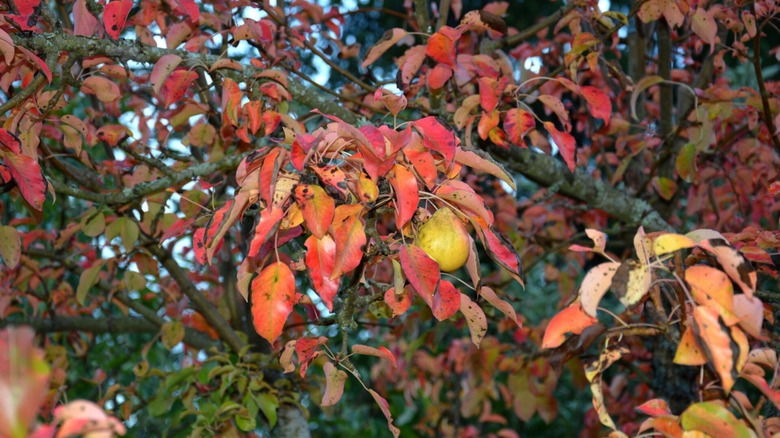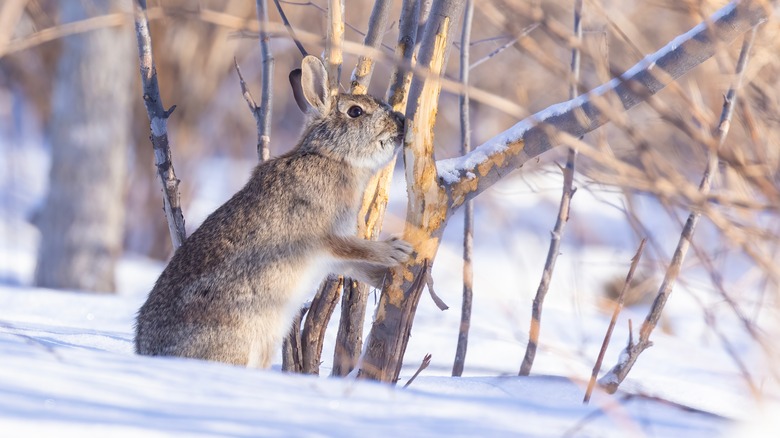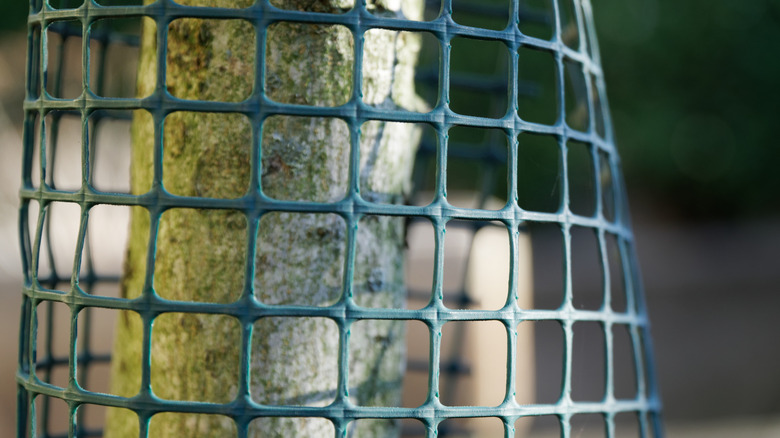Don't Skip This Essential Fall Task When Winterizing A Fruit Tree
The fall is passing swiftly, and like many homeowners, you're probably elbow-deep in preparation for winter, dutifully winterizing your sprinkler system and mulching the roots of your perennials. You may even be researching what the Old Farmer's Almanac predicts for the upcoming winter. But have you given any thought to protecting your fruit trees during the cold months to come? While your backyard apple tree may be hardy enough to brave the weather with no issues, you may still have marauding wildlife to worry about. The harsher conditions and lower availability of food in the winter may encourage local deer and rodents to nibble on the bark and trunk of your fruit trees. The attentions of nibbling animals may irreparably damage your tree, and installing a tree guard this fall can provide necessary protection.
Hungry rabbits, voles, deer, mice, and other furry forest dwellers gnaw through the bark of trees in lean winter months to get to the tender and nutritious cambium — the actively growing layer — just beneath. If they strip away too much of the bark around the trunk's circumference, they can inflict an injury called girdling, or ring-barking. Essentially, this cuts off the flow of nutrients between the tree's roots and its branches and is often fatal to the tree. The physical barrier of a tree guard can be your fruit trees' best defense against sustaining animal damage in the winter.
Selecting the best type of tree guard depends on a few different factors
In order to choose the appropriate size and type of guard for your fruit trees, think about what kinds of animals you generally see foraging in your yard: Is it mostly rodent and rabbit activity, or do you see deer, as well? A guard for rodent and rabbit protection should be at least four feet tall. This may seem taller than necessary, but keep in mind that accumulated snow changes the heights animals can access. Hardware cloth or mesh, with openings no larger than a quarter of an inch, is typically a solid choice. Small trees can also be protected with white corrugated plastic tubing wrapped around the trunk.
If deer are a common sight in your backyard, you'll be contending with more than just some lower trunk nibbling. In addition to eating bark and young buds, you'll have to worry about the damage they can do during the mating season. For white tail deer, this typically takes place in the fall and winter, depending on your location. Male deer rub their antlers on trees to smooth them and mark their territory, which can also result in girdling. Plastic tree guards or metal wire mesh tubes of a height of at least 6 feet above the anticipated snowline can prevent deer damage.
How and when to install tree guards
When installing a wrap-around tree guard, make the circumference wide enough that there will be about six inches between the guard and the tree trunk. Sink the bottom two or three inches of the fencing below the soil, and anchor it to the ground using landscape staples or tent spikes. Securing the guard to the ground will not only prevent burrowing yard pests from squeezing underneath, but it will also prevent the guard from rubbing on the tree trunk and causing wounds to the bark, especially if you're using metal mesh.
In general, you'll want to install your tree guards before the first snowfall. If you're using hardware cloth or mesh, you can leave them up year-round, as the holes provide adequate airflow, but make sure you keep an eye on them to avoid the tree outgrowing them. Tubes and other solid structures will need to be removed in the spring. One more consideration: Make sure you check your fences regularly while they're installed to make sure no bunnies or other small animals are trapped between the fence and the tree!


